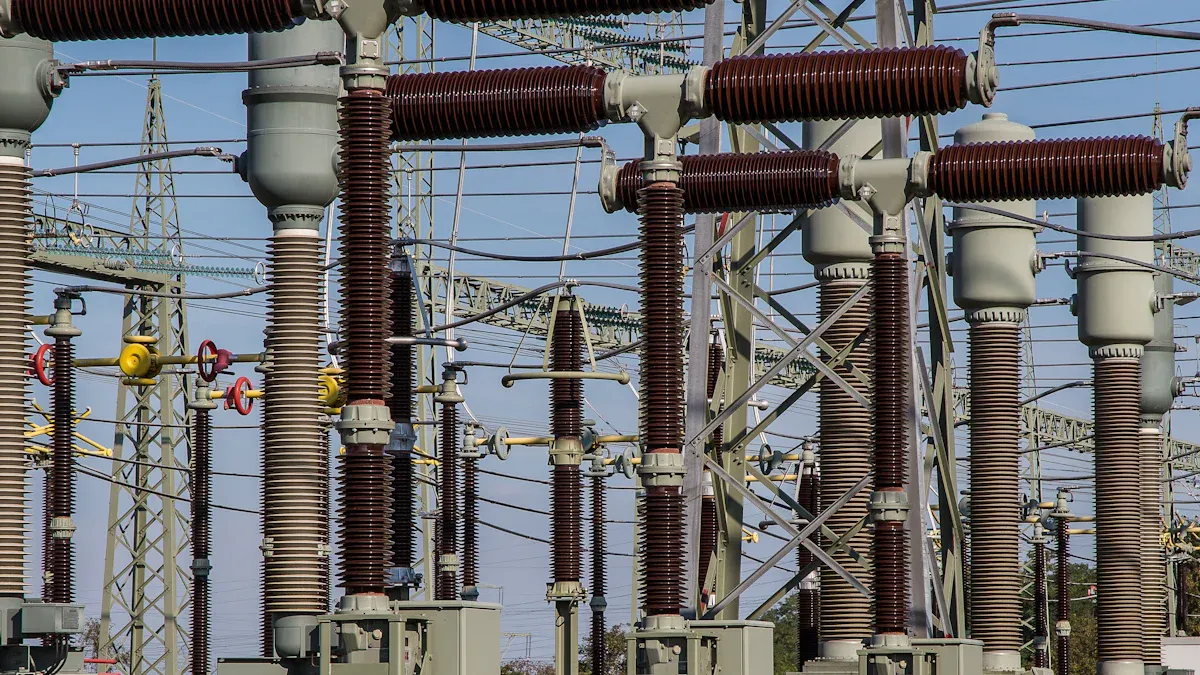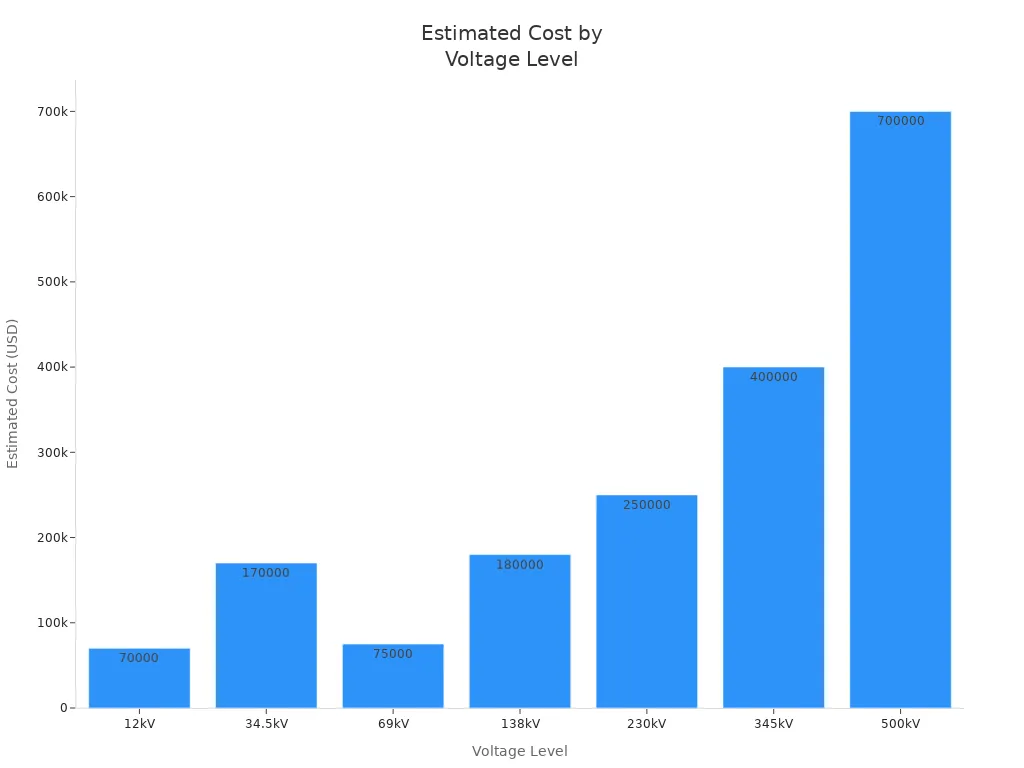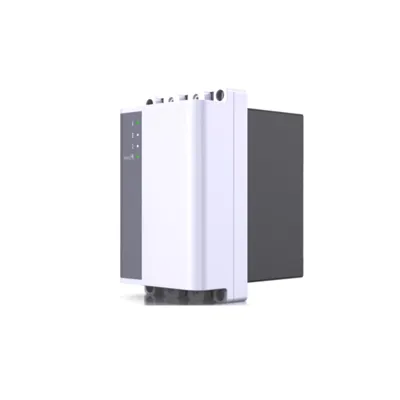Comparing Capacitor Banks for Efficiency
Explore the differences between low-voltage and high-voltage capacitor banks.
| Features | Low-Voltage Capacitor Bank | High-Voltage Capacitor Bank |
|---|---|---|
| Voltage Range | Up to 1 kV | Above 69 kV |
| Physical Size | Compact and lightweight | Large and heavy |
| Safety Requirements | Standard electrical safety | High, needs special training |
| Cost | Lower initial cost | Higher initial and maintenance costs |
| Typical Application | Commercial and light industry | Utilities and heavy industry |
| Installation Complexity | Simple and quick | Complex, requires experts |
| Maintenance Frequency | Regular checks needed | Less frequent, but costly |
| Energy Efficiency | Improves local power factor | Supports grid stability |
| Cooling Requirements | Fans for cooling | Requires special cooling systems |
You can see the main difference is in voltage range and use. Low-voltage capacitor banks are good for homes and small businesses. They also work well in small factories where saving energy is important. High-voltage capacitor banks are used in big factories and power grids. These places need help with large amounts of electricity. The table below shows where each type is best:
| Voltage Range | Application Environment |
|---|---|
| Low-Voltage (<1 kV) | Suitable for installations below 1 kV |
| High-Voltage (>69 kV) | Used in high-demand industrial and transmission areas |
Think about what your building needs. If you want special features like automatic control and live monitoring, Sinava Power Solution’s Low-Voltage Capacitor Bank has new technology. It helps manage power well.
Key Takeaways
Low-voltage capacitor banks work well in homes and small shops. High-voltage banks are used in big factories and power stations. Capacitor banks help save energy by fixing power factors. They also keep voltage steady, which saves money. Pick a low-voltage capacitor bank for small jobs. Use a high-voltage bank for places that need lots of power, like utilities. Both types need regular check-ups to stay safe and work well. Always ask an expert to help with installation. Think about how much power you need and how much space you have before you choose a capacitor bank.
What Is a Capacitor Bank?
Definition
A capacitor bank is a group of capacitors put together. They are joined in series or parallel inside a metal box. Many electrical systems use this setup. Shunt capacitor banks help with reactive energy and voltage control. They also help start motors. A capacitor bank is like a tool that balances electricity in a power system.
Using a capacitor bank makes your electrical system work better. This is true for both Low-Voltage Capacitor Banks and high-voltage ones.
Purpose
You may wonder why capacitor banks are important. They do many helpful things in electrical systems:
They store energy and help control electricity flow.
They make the power factor better, so energy is used well.
They keep voltage steady, so equipment works right.
They help your power system work better and more reliably by giving or taking reactive power when needed.
Both low-voltage and high-voltage capacitor banks do these jobs. The main difference is where and how you use them. Low-Voltage Capacitor Banks are best for small places. High-voltage banks are good for bigger, busier places.
Knowing about capacitor banks helps you pick the right one. You will learn more about each type in the next parts.
Low-Voltage Capacitor Bank
Features
A Low-Voltage Capacitor Bank has many smart features. Sinava Power Solution gives automatic help for reactive power. This lets your system fix the power factor by itself. You can see real-time data on a colorful TFT touch screen. The smart controller makes it easy to watch and control the system. The system reacts to changes very fast, in less than 20 milliseconds.
Several fans keep the cabinet cool and safe. The strong cabinet keeps all the parts inside safe. You also get busbars, fuses, switches, surge protection, capacitors, reactors, a power factor correction controller, and a power meter. All these parts work together to make your system strong and save energy.
Here is a table that lists features you often find in low-voltage capacitor banks:
| Feature Description | Details |
|---|---|
| Current Limiting Fuses | Provided on all three phases of each step |
| Voltage Transformer | Suitable rating for control power and voltage sensing |
| Internal Buswork | Tin plated copper, braced for high current |
| Flexible Power Cable | Copper conductor, safe insulation |
| Capacitor Elements | UL listed |
| Pressure Sensitive Interrupter | Protects against rupture, shows end-of-life |
| Discharge Resistor | Discharges voltage quickly |
| Dielectric Fluid | Biodegradable and non-toxic |
| Temperature Range | Works from -40°C to +70°C |
| Loss Design | Low loss, saves energy |
| Compliance Standards | Meets ANSI/IEEE and NEMA standards |
| Inrush Limiting Inductor | Minimizes inrush current |
| Contactor Specifications | Long life, switches capacitive currents |
| Controller Features | Microprocessor based, digital display, fault signaling |
Applications
You can use a Low-Voltage Capacitor Bank in many places. Factories use them to save energy and fix the power factor. Commercial buildings use them to lower bills and keep voltage steady. Hospitals and schools need them for steady and safe power.
The table below shows where you might use a Low-Voltage Capacitor Bank:
| Application Scenario | Description |
|---|---|
| Power Factor Correction | Makes your system more efficient and reduces costs |
| Voltage Quality Improvement | Keeps voltage levels steady and improves power quality |
| Harmonic Filtering | Reduces unwanted electrical noise and distortion |
When you pick a Low-Voltage Capacitor Bank, you get better energy use, more reliable power, and longer life for your equipment. Your system will also meet safety and quality rules.
High-Voltage Capacitor Bank

Features
High-voltage capacitor banks work with much higher voltages. These banks are bigger and heavier than low-voltage ones. They often need their own rooms or must be kept outside. The energy in a high-voltage capacitor bank uses the formula . If you raise the voltage a little, the energy goes up a lot. This is why you must be careful with these banks.E = 1/2 CV^2
High-voltage capacitor banks have strong insulation and metal cases. They also have protective relays and circuit breakers. Monitoring systems help keep everything safe. These banks need special ways to install and take care of them. You need trained workers and safety gear to work on them.
High-voltage capacitor banks cost more than low-voltage ones. They are bigger, use stronger materials, and need more safety parts.
Applications
You find high-voltage capacitor banks where lots of electricity is used or moved. These banks help big systems work better and save money. Here are some places they are used:
Mining industry: High-voltage capacitor banks help fix power factor and keep voltage steady. They also give reactive power support.
Manufacturing and industrial facilities: These banks help things run better and lower costs.
Power utilities and transmission: High-voltage banks help the grid stay steady and cut down on lost energy.
Renewable energy integration: They help balance power from wind or solar farms and support the grid.
High-voltage capacitor banks have many good points:
They make power factor better, so you use electricity well and avoid extra charges.
They cut down on wasted power and lower energy losses.
They help you pay less for energy by making your system work better.
They help your machines work well and last longer.
| Feature | High-Voltage Capacitor Bank | Low-Voltage Capacitor Bank |
|---|---|---|
| Voltage Range | Above 1 kV (often >69 kV) | Up to 1 kV |
| Physical Size | Large, needs special space | Compact, fits in standard panels |
| Safety Requirements | High, needs special training and equipment | Standard electrical safety |
| Cost | Higher initial and maintenance costs | Lower cost |
| Typical Application | Utilities, heavy industry, transmission | Commercial, light industry |
When you look at both types, high-voltage banks are best for big and complex systems. They help power grids and large factories, but they cost more and need more care.
Key Differences
Voltage Range
The biggest difference is the voltage each bank uses. Low-voltage capacitor banks work with systems up to 1,000 volts. You see these in small buildings and stores. They are also in light industry. High-voltage capacitor banks use much higher voltages, often above 69 kV. These are found in power plants and big factories. They are also used on transmission lines. The voltage you need depends on your system size and power use.
Design
Design changes how each bank works and where it goes. Low-voltage capacitor banks are small and fit in panels or cabinets. They use small parts and do not need much space. High-voltage capacitor banks are much bigger. You need a special room or outdoor spot for them. They have thick insulation and strong metal cases. They also use advanced switchgear. You must keep them away from people and other machines for safety.
| Feature | Low-Voltage Capacitor Bank | High-Voltage Capacitor Bank |
|---|---|---|
| Typical Location | Indoors, close to loads | Outdoors or in dedicated rooms |
| Size | Compact | Large, heavy |
| Components | Standard fuses, relays, controllers | Protective relays, circuit breakers |
| Installation | Simple, quick | Complex, needs experts |
Efficiency
Both types help you use energy better and waste less. Low-voltage capacitor banks fix power factor near where you use power. This means less energy is lost in wires. Your machines get better voltage quality. High-voltage capacitor banks help big systems like power grids. They support voltage and cut losses over long distances. The formula E = 1/2 CV² shows high-voltage banks store more energy. This makes them good for big jobs.
Tip: For small or medium buildings, put a Low-Voltage Capacitor Bank near your main panel. For power plants or utilities, use a high-voltage bank for grid support.
Cost
Cost is another big difference. Low-voltage capacitor banks cost less to buy and set up. High-voltage banks are much more expensive. They use bigger parts and stronger materials. They also need advanced safety systems. The table below shows cost estimates for different voltages and ratings:
| Voltage Level | MVAR Rating | Estimated Cost |
|---|---|---|
| 12kV | 4MVAR | ~$70,000 |
| 34.5kV | 10.8MVAR | ~$170,000 |
| 69kV | 14.4MVAR | ~$75,000 |
| 138kV | 65MVAR | ~$180,000 |
| 230kV | 100MVAR | ~$250,000 |
| 345kV | 150MVAR | ~$400,000 |
| 500kV | 230MVAR | ~$700,000 |

As voltage and capacity go up, prices rise fast. Always plan your budget for what your system needs.
Safety
Safety rules are different for each type. Low-voltage capacitor banks follow rules like ANSI/UL 810B Part II for up to 600 V. High-voltage banks must meet stricter rules, such as ANSI/UL 810B for up to 7.2 kV. They often need even more safety features.
Both types need overload protection, like fuses or circuit breakers.
Good systems use pressure-sensitive disconnectors for safe shutdowns.
Always turn off and discharge capacitors before working on them.
Only trained workers with special gear should work on high-voltage banks.
| Standard | Voltage Level | Region |
|---|---|---|
| ANSI/UL 810B Part II | 600 V or less | U.S. and Canada |
| ANSI/UL 810B | Up to 7.2 kV | U.S. |
Note: Check both types often and handle them with care. High-voltage banks need more checks and stricter safety steps.
Pros and Cons
Low-Voltage Capacitor Bank
Using a low-voltage capacitor bank gives you many good things. These banks help your system run better and use less energy. They also keep voltage steady, which helps protect your equipment. Here is a table that lists the main benefits:
| Advantage | Description |
|---|---|
| Power Factor Correction | Improves efficiency by reducing reactive power losses. |
| Voltage Stability | Minimizes voltage changes, especially during sudden load shifts. |
| Energy Savings | Cuts down on energy losses, helping you save money. |
| Increased System Capacity | Lets you use more active power by lowering reactive power needs. |
| Substation Voltage Support | Keeps voltage within safe limits during high demand. |
| Grid Reliability | Reduces risks of voltage drops, making your power supply more stable. |
Tip: Low-voltage capacitor banks are great for places like schools, hospitals, and small factories.
But there are some problems you should know about. These banks can be affected by certain electrical issues. Here is a table with common problems:
| Disadvantage | Description |
|---|---|
| Harmonics | Sensitive to harmonic currents, which can shorten lifespan. |
| Resonance | May create paths for unwanted currents, risking equipment damage. |
| Load Changes | May not work well if your load changes often. |
| Maintenance Issues | Needs regular checks, or performance may drop. |
| Equipment Damage | If not disconnected during outages, can cause surges. |
High-Voltage Capacitor Bank
High-voltage capacitor banks give strong help to big power systems. You will find these banks in power plants and large factories. They help move electricity far and support renewable energy. Here are some main benefits:
| Advantage | Description |
|---|---|
| Cost-Effective | Cheaper than building new power plants for grid support. |
| Ease of Maintenance | Fewer moving parts mean less frequent repairs. |
| Remote Monitoring and Control | Lets you check and adjust performance from far away. |
| Renewable Energy Access | Helps bring wind or solar power from far places to where you need it. |
Still, high-voltage capacitor banks have some downsides:
Bulky size: You need a lot of space to put them.
Limited load range: They work best with certain power levels.
Maintenance requirements: You may need to change parts over time, which can cost more.
Comparison Table
Here is a quick look at both types side by side:
| Feature | Low-Voltage Capacitor Bank | High-Voltage Capacitor Bank |
|---|---|---|
| Main Use | Small to medium buildings | Utilities, large industry |
| Space Needed | Compact | Large, needs special area |
| Cost | Lower | Higher |
| Maintenance | Needs regular checks | Less frequent, but can be costly |
| Flexibility | Good for changing loads | Best for steady, high loads |
| Harmonic Sensitivity | Higher | Lower |
| Remote Control | Available in advanced models | Standard feature |
Remember: Pick the type that fits your power needs, space, and budget.
Choosing the Right Solution
Factors
When you pick between a low-voltage or high-voltage capacitor bank, you must think about some key things. Each thing helps you find the best fit for your needs. The table below shows what to look at:
| Factor | Description |
|---|---|
| Capacitance and voltage | Make sure your system gets the right capacitance and voltage. |
| Charging strategy | Plan how you will charge the capacitors and see how it changes how they work. |
| Hold time | Think about how long the capacitor needs to keep its charge. |
| Discharge time | Find out how fast the capacitor lets out its energy. |
| Expected ringing period | Check how the circuit deals with voltage swings or "ringing." |
| Voltage reversal | Watch for voltage going backward during discharge, which can be unsafe. |
| Desired shot life | Guess how many times you will charge and discharge before you need a new one. |
| Target pulse repetition rate | Decide how often the capacitor will cycle, and make sure cooling and materials can handle it. |
Tip: Always pick a capacitor bank that matches your system’s voltage and power needs. This gives you the best results and makes it last longer.
Scenarios
Different places need different capacitor banks. Here are some times when a low-voltage capacitor bank is a good choice:
You want to make power factor better in a small factory or store.
You need to keep voltage steady and stop voltage drops.
Your power lines are inductive and need help.
You might need a high-voltage capacitor bank if:
You work in a big factory or utility that uses a lot of power.
You need to help a power grid or transmission line.
Your system needs a lot of reactive power correction.
Note: Low-voltage capacitor banks are best for places like schools, hospitals, and offices. High-voltage banks are better for power plants and big factories.
You learned that low-voltage capacitor banks are good for small places like schools and offices. High-voltage capacitor banks are better for big factories and power companies. Each type helps in its own way. To get the best results, you should pick the right design and put it in the right spot. Make sure to check and take care of it often. You should also ask an electrical engineer to help you choose the right size and where to put it. Sinava Power Solution can help you find the best option for your power system.



